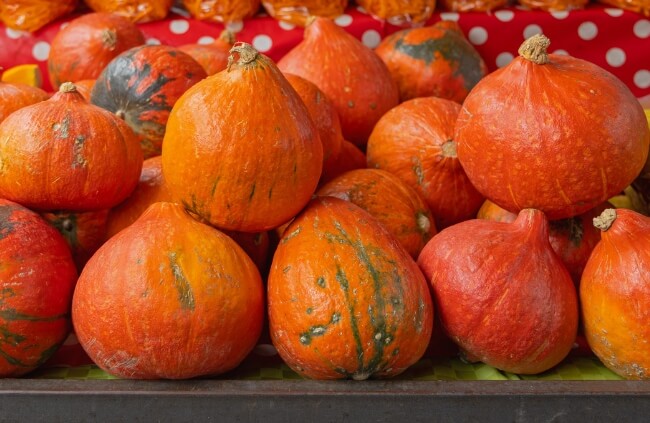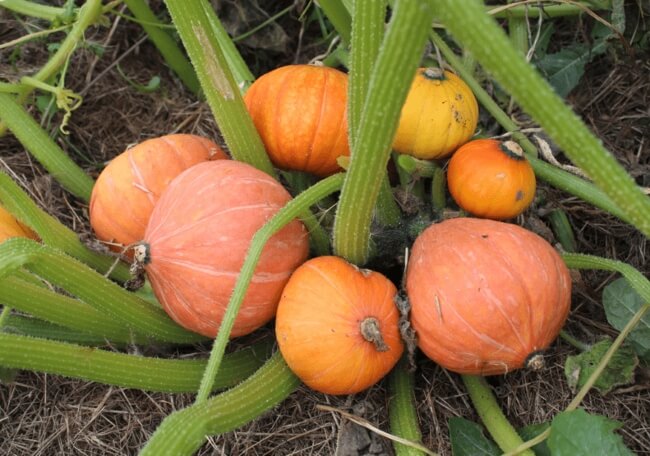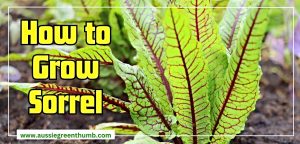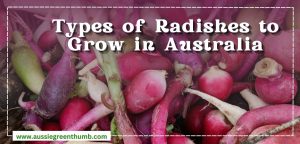As one of the smallest pumpkin plants available, Golden Nugget, is an ideal vegetable to grow at home. If you have a small veggie patch or limited growing space in your garden, Golden Nugget pumpkin is a perfect option. They can even be grown in large pots or containers.
The plant produces lots of attractive, orange-skinned fruit. These versatile pumpkins can be stored for an extended period and cooked in a wide variety of dishes. They are delicious roasted!
This gardening guide provides all the information you need to successfully grow and care for golden nugget pumpkins from seed sowing through to harvest.
More...
Botanical name: | Cucurbita maxima (Golden Nugget) |
|---|---|
Botanical family: | Cucurbitaceae |
Introducing Golden Nugget Pumpkin

Cucurbita maxima is a species of the Cucurbitaceae family of squashes, melons, and gourds. This cultivar of Cucurbita maxima is commonly known as Golden Nugget Pumpkin, Golden Nugget Squash, Oriental Pumpkin and Gold Nugget Squash.
Golden nugget pumpkins have smaller running vines than larger pumpkin plants and are often described as Bush pumpkins.
The plant produces small-medium sized fruit approximately 10-15 cm in diameter. These round, orange and flattened fruit have a hard ridged skin and deep-yellow sweet-tasting flesh.
You can bake, boil, steam or mash the fruit. Due to their relatively diminutive size, they are often roasted whole. Pumpkins are a good source of vitamin A. Golden nugget pumpkin is a warm-season crop, which you can grow almost all year round, in tropical parts of Australia.
These plants are tender and prone to damage from frost, so only propagate after the last frost of spring.
How to Grow Golden Nugget Pumpkin
Best Soil for Cucurbita maxima
Golden nugget pumpkin will tolerate most soil types but like rich, fertile soil. Your soil should also be free draining so that the plant doesn’t become waterlogged. For best growing results it’s recommended that you add some compost before planting.
Where to Position Golden Nugget Pumpkin in Your Garden
These nugget pumpkins like full sun and space. A sunny spot in the garden will give the plant the best chance of success and produce the most fruit. If planting in a veggie patch, position it towards the edge of your growing space, so it can grow away from the other plants.
Golden nugget pumpkin vines can spread rapidly and can easily take over other plants, so it is important to train the vines away from their neighbours. Alternatively, if you want to grow the pumpkin vertically you will need to set up a solid trellis structure.
How to Grow Cucurbita maxima from Seeds
The good news is that it is possible to grow this squash in most parts of Australia. Just wait until the chance of frost has gone and the weather is beginning to warm up. It’s best to plant after the temperature regularly begins to exceed at least 18°C as the soil will need to be warm enough for the seeds to germinate.
In cold climates sow seeds from October to December. In temperate climates, you can sow Golden nugget pumpkin seeds from September to December. In subtropical zones, sow from August to February. In tropical parts of Australia, you can sow seeds almost all year round, especially if raising early plants in punnets or pots.
Typically, you would sow Golden nugget pumpkin seeds directly into the garden veggie patch. Ideally, space the plants about 75 cm-1 m apart and allow 1 m between rows.


Get Your Free Guide:
Master Growing Australian Natives eBook
A Must Have Complete Guide for Every Australian Garden
Get Your Free Guide:
Master Growing Australian Natives eBook
A Must Have Complete Guide for Every Australian Garden
Sow seeds to a depth of around 10-20 mm, directly into small mounds of compost. This will ensure that the plant has adequate nutrition and drainage. Include around 5 seeds in each clump. Keep the plant well-watered until the seed germinates.
Seedlings should begin to emerge in just over a week. Thin down the seedlings leaving 1-2 of the strongest, healthiest plants. Although best grown in an in-ground veggie patch, you can also grow Golden Nugget squash from seed in a large container or pot if you have a small garden.

Source: Active Vista
Growing Golden Nugget Pumpkin in a Pot
Many larger varieties of pumpkin aren’t suitable to be grown in a container or pot. They simply take up too much space and the fruit are too large. If you have limited space in the garden and want to grow pumpkin in a pot, then Golden Nugget is your best option.
You will still need a fairly large container to successfully grow golden nugget pumpkin in a pot. Select a container with a minimum depth of at least 30 cm. Use a good quality potting mix and consider adding some organic material to help the plant along.
Keep your seedlings well-watered. The plants are prone to drying out, especially when planted in pots.
Caring for Golden Nugget Pumpkin
You have two distinct options when growing pumpkin. You can choose to let them sprawl and grow at ground level or you can grow the plant vertically. Growing vertically saves space and allows you to display the attractive leaves and fruit.
The Golden Nugget plant has a shallow root system so will need some support and protection. If you’re growing at ground level, you should also peg down the vine at regular intervals to avoid wind damage.
Likewise, if growing on trellis, you should regularly attach the vines to the structure, to give the plant more stability and encourage the plant to branch out. Pinching out the growth tips of the plant will cause the plant to fork, increasing the size of the plant and the amount of produce.
All pumpkin plant varieties can struggle sometimes with pollination. To help things along you can hand pollinate. This is an easy process that simply involves rubbing the male flowers inside the female flowers.
Male flowers should be the most prevalent on the plant and further off the vine. Female flowers can be identified by looking for a tiny pumpkin in between the flower and stem. They will also be attached close to the main stem. Hand pollination can increase the amount of fruit your plant produces.
The other bit of maintenance work needed when growing golden nugget pumpkins is to ensure that the plant is fed enough. To satisfy its nutrient requirements you should consider adding some seaweed fertiliser about once a fortnight.
Water the plant consistently and regularly. They require a lot of water during the growing season. Given its shallow root system, it can be prone to drying out.
Mulch will help retain water in the soil. Apply to a depth of about 5 cm. If growing golden nugget pumpkin at ground level, mulch around all areas where the vines might spread, as it will also help the plant avoid the risk of disease and fruit rot.
Harvesting Golden Nugget Pumpkin

When to Harvest Golden Nugget Pumpkin
Like other pumpkins, the Golden Nugget squash is typically harvested when the vine dies, and the fruit stalk is dry and brittle. At this point, the fruit will be fully mature and will have the best flavour.
You can however pick the squash, whenever you want after it is fully coloured. They are considered ripe when there isn’t any green skin on the stem. This is typically about 14-16 weeks after sowing the pumpkin seeds.
Depending on when you sow the seeds, golden nugget pumpkins will be ready to harvest from March. In the southern states, they won’t be mature until the end of Autumn.
How to Harvest Gold Nugget Pumpkin
To harvest the fruit, use a knife to cut the pumpkin from the vine. Cut at about 5 cm below the stem to improve storing ability of the fruit. Avoid using the stalk as a handle or it may break off.
Each Golden Nugget plant should bear approximately six to ten small, round, orange fruit. If you feel so inclined, most of the plant is also edible including the shoots, flowers, leaves and seeds.
Storing Gold Nugget Pumpkin
Pumpkins will store better if you allow them to dry in the sun for up to 3 days after harvesting. Golden nugget pumpkins can then be stored for long periods. Keep them in a cool, dark spot until cut.
Given the diminutive size of Golden Nugget squash, it is unlikely you’ll have leftovers that you will want to store. If you do, remove the seeds, wrap the remaining pumpkin in a plastic bag and store it in the refrigerator.
Golden Nugget Pumpkin Plant Pests and Disease
These plants are susceptible to powdery mildew. Powdery mildew on golden nugget pumpkin can be identified by powdery white blotches that form over the leaves. It’s typically caused by humid weather and poor airflow. Although powdery mildew isn’t fatal, as the white spots spread over the plant it impacts photosynthesis and the production of fruit.
Ensure you give your golden nugget pumpkin enough space to breathe and get sufficient airflow. Grow the plant in a sunny spot and avoid shady, humid areas. Also try and water the plants in the morning, which will allow the patch to dry out over the day.
As an organic solution, you can use a milk spray (full-cream milk in water 1:10 ratio) to treat powdery mildew. Alternatively, you can treat the affected areas with a sulphur-based fungicide.
Wrapping Up Our Guide to Growing Golden Nugget pumpkin
Golden Nugget is one of the most popular and manageable pumpkins available for home gardeners. It’s also the perfect pumpkin to grow if you have limited space. Send us a message if you have any questions about how to grow golden nugget pumpkin in your veggie garden or a container pot.
Published on August 23, 2023 by Gary Clarke
Last Updated on January 21, 2025




